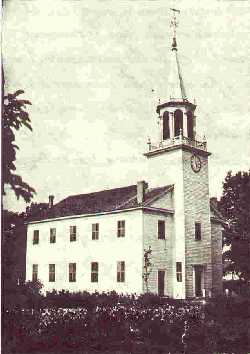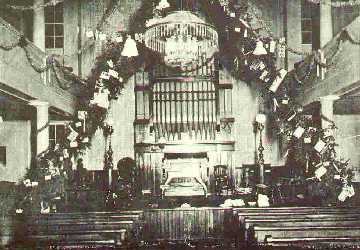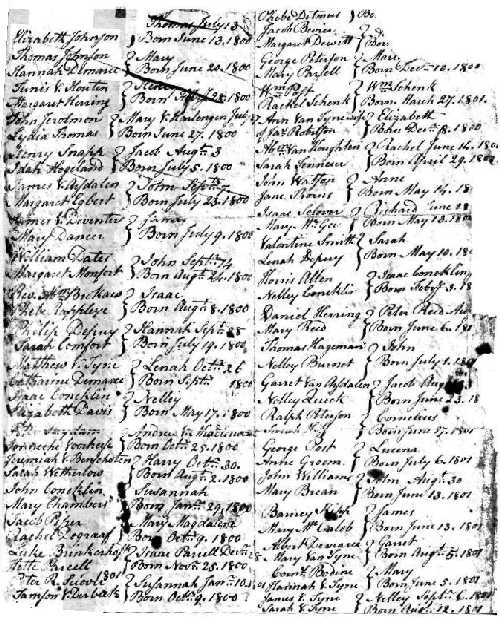
Ten Most Wanted | Picture Gallery | Contact | Home | Links | Archive Room | Name Index
Archives: From Pennsylvania to New York in Covered
Wagons
This story is about the family of John Bodine, the probable son of Abraham Bodine and Mary Low. He was born in Somerset County, New Jersey and baptized at either the North Branch DRC or the Readington DRC on May 15, 1743. His wife was Lemme Cozyn (or Cosine), the daughter of Cornelius Cosine and Ann Staats. This family left Somerset County in the late 1760's to move to Pennsylvania.
According to the article Migration from New Jersey to the Conewago Colony, Pa., 1765-1771, by A. Van Doren Honeyman, large numbers of families left Somerset and Bergen Counties in New Jersey to settle in the vicinity of Gettysburg, Pennsylvania. This happened right before the Revolutionary War. The Bodines were among a number of Dutch families to settle in an area between Hunterstown and Two Taverns, a little east of Gettysburg. The earliest emigrants arrived in 1765 and the main migration was in 1771. A church was formed in 1769 and was served by two pastors: Rev. Cornelius Cosine (1772-1788) and Rev. George G. Brinkerhoff (1788-1793). The church was called the Reformed Dutch Church of Conewago. No town was actually formed, but the settlers lived along what came to be known as the Low Dutch Road.
Almost all of John and Lemme Bodine's children were baptized at the Conewago DRC. Only the first child, Abraham, may not have been born there. He was born in 1767, probably before John and Lemme made the trip to Conewago; although, it is possible that even Abraham was born in Conewago. His birth would have been before the church kept records. Their second child, Cornelius, was baptized in May of 1770. Therefore, the Bodines may have made the trip to Pennsylvania around 1768 or 1769. The records of taxables show that John owned around 170 acres of land up until 1786 at which time he must have died. Thereafter, his wife, Lemme, appears as a widow and has the land that once was in John's name.
At one point, a number of the settlers were killed by Indians and many of their houses burned down. Eventually, the settlers began emigrating to other areas, first Kentucky and later New York. In about 1793, a large number of the Dutch pioneers pulled up stakes and moved to the Cayuga County region of New York. This pretty much put an end to the Conewago colony. Those who were left, blended in with the other pioneers in that area and the church soon closed its doors.
A wonderful record of the trip that some of the Dutch settlers took to New York was recorded by John Brinkerhoff (The Early Settlement of Cayuga County. Cayuga County Historical Society: Auburn, New York. 1882). The author was the son of Jacob Brinkerhoff, one of ten heads of families who left Gettysburg, Pennsylvania on April 30, 1793 in covered wagons to make the long trip north. Another one of those heads of families was Abraham Bodine, the oldest son of John and Lemme.
The following is a quote from the Brinkerhoff article:
**********
My father, with his wife and seven children, the oldest sixteen years and the youngest ten months, with his brother Roeliff Brinkerhoff, with his wife and eight children, with Thomas Johnson, Abraham Bodine, Charles Van Time, Luke Brinkerhoff, James Dates, Isaac Parsell, Jacob Loyster and Andrew Johnson with their families, but I don't know how many children they all had with them.
The company named above, of ten families, left Gettsyburg, Pennsylvania, April 30, 1793. They came with tented wagons, and brought with them as much as they could of provisions and household stuff that would be necessary for them by the way, and on their arrival in what is now the wilderness of Cayuga County, N.Y.; they got to this county the 4th of July, having been two months and four days on the way.
Perhaps it would be of some interest to give a narrative of their long journey, as I have often heard it related by my parents and others. The state of Pennsylvania had for some time been engaged in opening a road through the wilderness to (as it was called) the Genesee Country, New York. Gangs of men were working on the different sections. This was their road to travel, of course it was rough road, the trees cut down and the logs got out of the way and then a corduroy bridge over swampy places, so that wagons could pass, so their progress was slow.
Sometimes they would come to the end of the road, that is, they would come up to a company of men who had not got through their section, and they would send a few men with axes and help them through to the next section.
They did not find any commodious hotels on the highway, but every family who had got up a house would take in all their little house would hold. So when near night they came to one of these houses, they would take bedding enough out of the wagons, to cover the floor, and the women and children would sleep in the house, and the men would sleep in the wagons; and when night overtook them, and there was no house, the women and children would sleep under the tents in the wagons, and the men on the ground under the wagon.
So they came on until the came to the Susquehanna river, near the junction with the Chemung river. There they were held about two weeks, on account of high water, so they had to wait for some of the water to run by before they could ford the river. From there they came on to Cayuga flats, where the village of Ithaca now is. There they found a few settlers in log cabins. From there they went north on the east side of Cayuga Lake to what I think is in the (now) town of Genoa. There they found some cleared land or Indian Fields. Here they concluded to stop.
They put up some cabins for shelter; and, although it was late, they put in some seed, and took time to look around and see where they would decide to make a permanent settlement.
I don't remember of hearing them speak of a case of sickness in their long and tedious journey. They remained in this place until the spring of 1795. In that time they explored the country around them, and purchased lands near the foot of Owasco Lake, most of them on the east side. My father and my uncle (his brother) purchased and settled on what is now called Brinkerhoff's Point, and took possession in the spring of 1795. Here the writer was born (February 17th, 1803) and now resides in the same place...
They organized a religious society connected with the Dutch Reformed Church. Emigrants came in the new wilderness settlement quite rapidly in 1795 and 1796. And in the summer of 1797 they erected a church edifice, it was built of hewn logs, 25x30 feet, with a gallery on three sides, with slab seats. It was located on the land owned by the writer's father (Jacob Brinkerhoff) which is now owned by his grandson (the writer's son) of the same name (Jacob Brinkerhoff).
It stood a few rods south of the bridge at Brinkerhoff Point six miles from Auburn, and was the first church edifice erected in this county. It was continued in use until 1815, when a new one was built in Owasco Village, as it would seem, something of an undertaking in these days of 1882.* See the pictures below.

Owasco Village DRC

**********
The article goes on to explain more about life in that area at that time, but the main information about the trip from Pennsylvania to New York is included above.
Below is a copy of one side of the surviving baptismal fragment of the Old Log Meeting House near Brinkerhoff Point (now Burtis Point). In the bottom right appears the baptism of Mary Bodine, the first child of Cornelius Bodine and Hannah Van Tyne. Mary was born June 5, 1801. My appreciation to Laurel Auchampaugh for a copy of this fragment. Laurel is a descendant of Cornelius Bodine through his daughter, Hannah J. Bodine and her husband, Morgan Lewis Mattoon.

Laurel is also the historian for Owasco, New York. She thinks that Lemme remained in the Conewago area for several years with the younger children and then joined her older sons, Abraham and Cornelius, after 1799. This would seem to make good sense since at least Lemme, her sons, Peter and probably John, and her daughter, Mary, were still in the York County area at the time of the 1800 Census.
Lemme (Cozyn) Bodine is buried in the Selover Cemetery in Niles, Cayuga County. The location of John Bodine's grave is unknown. However, there were a couple of cemeteries in existence along the old Low Dutch Road near Gettysburg where many of the Dutch pioneers were buried. I'm not sure if these exist today, but maybe John was buried in one of the many unmarked graves in those cemeteries.
For more information on the Conewago colony and the early settlement of Cayuga County, see the links under Church Records in the Archives Room of my web site.
The information in this story is derived from the articles mentioned above by A. Van Doren Honeyman, and John Brinkerhoff, as well as The Low Dutch Colony of the Conewago, by Rev. J.J. Demarest (1884), and a story in the Star and Sentinel, Gettysburg, Pennsylvania, January 8, 1884.
If anyone would like some nicely done copies of the full story about the early settlement of Cayuga County (by John Brinkerhoff), the surviving baptismal fragment from the Old Log Meeting House near Brinkerhoff Point, the Articles of Association (the agreement to build the Meeting House in Owasco Village, with signatures), and the secession subscription list / the doctrine of atonement dispute and signatures of some of the supporters, these are available. Please send $6 plus $3 postage to:
| Cayuga County Historians Office Publications - Owasco Booklets 157 Genessee Street Auburn, New York 13021 |
*The building referred to still exists today. It is unchanged except for the height of the steeple.
Ten Most Wanted | Picture Gallery | Contact | Home | Links | Archive Room | Name Index